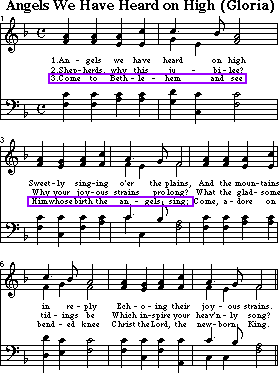Phrasing the Text
A hymn has two main parts: a text and a tune. In most cases the two were not created together. Instead, a hymn text of a certain meter is matched with a tune of the same meter.
For example, the text, “Come, Ye Children of the Lord,” with the meter 7 7 7 7 D, was created by James H. Wallis (1861-1940). The text was matched to an old tune in the same meter, “Spanish Melody,” which was arranged by Benjamin Carr around a century earlier.
Partly because texts and tunes are not always created together, the phrasing of the text often differs from that of the tune. Notice, for example, in the third verse of the hymn to the right, “Come to Bethlehem and see him whose birth the angels sing” (purple outline). This single textual thought (or sentence) spans two short musical thoughts (or [half-] phrases) of the tune to which the text is set, “Gloria.” To break the text between “see” and “him” would result in two incomplete thoughts.
